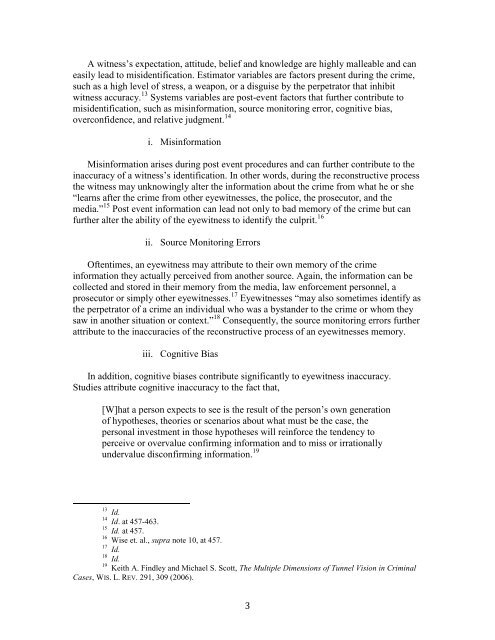dada_floridamisidentification_final - UDC Law Review
dada_floridamisidentification_final - UDC Law Review
dada_floridamisidentification_final - UDC Law Review
- No tags were found...
You also want an ePaper? Increase the reach of your titles
YUMPU automatically turns print PDFs into web optimized ePapers that Google loves.
A witness’s expectation, attitude, belief and knowledge are highly malleable and caneasily lead to misidentification. Estimator variables are factors present during the crime,such as a high level of stress, a weapon, or a disguise by the perpetrator that inhibitwitness accuracy. 13 Systems variables are post-event factors that further contribute tomisidentification, such as misinformation, source monitoring error, cognitive bias,overconfidence, and relative judgment. 14i. MisinformationMisinformation arises during post event procedures and can further contribute to theinaccuracy of a witness’s identification. In other words, during the reconstructive processthe witness may unknowingly alter the information about the crime from what he or she“learns after the crime from other eyewitnesses, the police, the prosecutor, and themedia.” 15 Post event information can lead not only to bad memory of the crime but canfurther alter the ability of the eyewitness to identify the culprit. 16ii. Source Monitoring ErrorsOftentimes, an eyewitness may attribute to their own memory of the crimeinformation they actually perceived from another source. Again, the information can becollected and stored in their memory from the media, law enforcement personnel, aprosecutor or simply other eyewitnesses. 17 Eyewitnesses “may also sometimes identify asthe perpetrator of a crime an individual who was a bystander to the crime or whom theysaw in another situation or context.” 18 Consequently, the source monitoring errors furtherattribute to the inaccuracies of the reconstructive process of an eyewitnesses memory.iii. Cognitive BiasIn addition, cognitive biases contribute significantly to eyewitness inaccuracy.Studies attribute cognitive inaccuracy to the fact that,[W]hat a person expects to see is the result of the person’s own generationof hypotheses, theories or scenarios about what must be the case, thepersonal investment in those hypotheses will reinforce the tendency toperceive or overvalue confirming information and to miss or irrationallyundervalue disconfirming information. 1913 Id.14 Id. at 457-463.15 Id. at 457.16 Wise et. al., supra note 10, at 457.17 Id.18 Id.19 Keith A. Findley and Michael S. Scott, The Multiple Dimensions of Tunnel Vision in CriminalCases, WIS. L. REV. 291, 309 (2006).3














